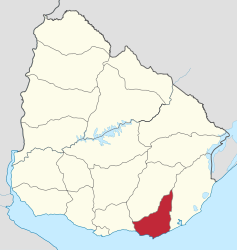Maldonado Department
| Maldonado | |||
|---|---|---|---|
| Symbols | |||
|
|||
| Basic data | |||
| Country | Uruguay | ||
| Capital | Maldonado | ||
| surface | 4793 km² | ||
| Residents | 164,300 (2011) | ||
| density | 34 inhabitants per km² | ||
| ISO 3166-2 | UY-MA | ||
| Website | www.maldonado.gub.uy (Spanish) | ||
| politics | |||
| Intendant | Óscar de los Santos | ||
| Political party | Front Amplio | ||
Coordinates: 34 ° 39 ′ S , 54 ° 53 ′ W

Maldonado is a department in the south of Uruguay . It is one of the most populous in the country. Its capital Maldonado has 62,592 inhabitants (as of 2011) and is one of the larger cities of Uruguay.
geography
location
The department, which covers an area of 4793 km², borders Canelones to the west and Lavalleja and Rocha to the north and east . In the south it is bounded by the Río de la Plata , which merges into the Atlantic Ocean in this department . In the southeast you can find many lagoons such as the Laguna del Sauce, del Diario, Blanca, José Ignacio and Garzón. In the region you will find beautiful trees and mountain ranges, which offer a unique nature on the southern tip of the American continent.
Natural resources
In the department area there are marble deposits in the Sierra de Carapé and partially on the Arroyo Pan de Azúcar , as well as at Zanja del Tigre on the Ruta 12 , where dolomite is also found. Further mineral resources are stored in the Mina Chape ( lead and zinc ), in the Mina Volcano ( copper ), in the Mina La Oriental (copper and zinc) and in the Mina Apolonia (lead, copper and zinc). At Piriápolis there are deposits of gray and red granite . The city of Maldonado is waiting with Limos in inventories directly.
history
Originally lived here u. a. the Charrúas and the Chanaes .
The three natural harbors of the Río de la Plata in Maldonado, discovered by the first seafarers when they sailed into the wide estuary, ensured that the area was settled as early as 1600, but it wasn't until 1673 that the Spanish discovered the area for Europe .
Residents
While 140,192 inhabitants were counted in 2004, the number of inhabitants determined in the 2011 census was 164,300. Of these, 80,865 were men and 83,435 women.
Infrastructure
education
Maldonado has a total of eleven secondary schools ( Liceos ), in which 10,284 students are taught by 892 teachers. The oldest Liceo in the department is the Liceo Nº 1 Departamental "Florencio Collazo" , which was established in the department capital Maldonado and was founded in 1913 . (As of December 2008)
traffic
In the area of the department there are two connections to the air traffic with the airport El Jagüel and the airport Capitán de Corbeta Carlos A. Curbelo . The Montevideo - Rocha railway runs through the department , and at kilometer 144 there is a junction to the south to the Maldonadian capital. Furthermore, the following roads run through the department: Ruta Interbalnearia , Ruta 9 , Ruta 10 , Ruta 12 , Ruta 13 , Ruta 39 , Ruta 60 .
economy
Tourism is particularly important in the region . On the peninsula, which forms the border between the Río de la Plata and the Atlantic, lies the seaside resort of Punta del Este , which is one of the most famous in South America, primarily because of its location and nightlife. Another tourist spot is the town of Piriápolis , which was founded at the turn of the 19th and 20th centuries based on the model of the French and Italian Riviera . The capital Maldonado is also of central importance .
politics
The current director of the department has been Óscar de los Santos since 2005 , who, however, was temporarily replaced by Gustavo Salaberry at the beginning of 2010 , but was re-elected for a second term until 2015 in the following local election on May 9, 2010 .
The Junta Departamental of Maldonado , the parliament of the department consisting of 31 ediles , has been President Andrés de León (born August 5, 1974) ( Frente Amplio ) since its election on July 7, 2011 for the period from July 2011 to July 2012 . The Parliament currently (as of February 26, 2012) consists of 17 Ediles of the Frente Amplio, ten of the Partido Nacional and four of the Partido Colorado members.
Web links
- Maldonado.gub.uy
- Photos from the Maldonado Department (German, English, Spanish)
- Maldonado in the Enciclopedia Geografica del Uruguay (Spanish)
Individual evidence
- ↑ Ulises Rubens Grub : Atlas geografico de la República Oriental del Uruguay, Montevideo 1980, p. 35
- ↑ Statistical data of the 2011 census ( memento of the original from September 27, 2015 in the Internet Archive ) Info: The archive link was inserted automatically and has not yet been checked. Please check the original and archive link according to the instructions and then remove this notice. of the Instituto Nacional de Estadística de Uruguay , accessed on August 29, 2012 (XLS file; 25 kB)
- ↑ Liceos del Uruguay (Spanish) (PDF; 7.3 MB), accessed on February 29, 2012
- ↑ Ulises Rubens Grub: Atlas geografico de la República Oriental del Uruguay, Montevideo 1980, p. 37
- ↑ Ulises Rubens Grub: Atlas geografico de la República Oriental del Uruguay, Montevideo 1980, p. 39
- ↑ Discurso de Gustavo Salaberry al asumir como Intendente Municipal de Maldonado - February 5, 2010 ( page no longer available , search in web archives ) Info: The link was automatically marked as defective. Please check the link according to the instructions and then remove this notice.
- ↑ Internet presence of the Junta Departamenta of Maldonado (Spanish), accessed on February 26, 2012



